The former Made in Chelsea star, 27, and fellow cast member boyfriend Josh Patterson, 28, welcomed their daughter India in June.
She gave birth just five months ago, yet Binky Felstead has already managed to get her gorgeous figure back. And while it’s easy to presume celebrity mothers must be blessed with good genes, she has revealed that she has worked hard for it.
Now, celebrity trainer Lulu Adams has shared with Healthista the fitness regime she got Binky doing to shift the baby weight.
She wants to help and inspire new mothers looking to get back into shape, and she warns there’s a right and wrong was to do postnatal exercise.
The former Made in Chelsea star, 27, welcomed baby India just five months ago

The former Made in Chelsea star began her exercise sessions just eight weeks into motherhood

Binky revealed, as shared a video of herself working out on Instagram, that she began her exercise sessions just eight weeks into motherhood.
However, she recognises that celebrities’ fast track to baby weight loss can leave new mothers feeling down about themselves and urged women to not feel pressured.
‘Just because I’ve made the decision to start working out, shouldn’t make other mothers feel bad or pressured to if they haven’t! Each to their own, do what makes YOU feel good’, she wrote.
Lulu said: ‘I focus predominately on core rehab but we’ve done workouts that high intensity training but low impact which is safe for someone recovering.
‘We’ve slowly introduced more resistance but that doesn’t need to be dumbbells. Resistance bands are great for new mums.’

Below she shares 19 rules she now has Binky following.
1. Appreciate your body has been through a lot of change
As we grow through pregnancy, the natural S shape of the spine tends to become slightly distorted where the uterus pulls the lower back down into a big arch. As boobs grow the upper body compensates as well.
These things cause quite a lot of pain and discomfort in day to day life during pregnancy and going forward.
2. Understand the abs need special care
As your baby grows it pushes everything else out of the way such as the bowel and diaphragm. Most diastasis recti – the gap that occurs during pregnancy between the abdominal muscles – can heal itself within 8-10 weeks.
But a lot of people need helping hands and rehabilitation exercises to get it going. When I see a client I’ll have a look at their abdominal wall by doing a palpation test.
I’ll have them lie on the floor and lift their head into a mini crunch and I push down on the connective tissue that runs between the two muscles of the abdomen.
That gives me a good picture of how they are healing and what sort of exercises we need to look at.
3. How to retrain the core
Whatever the case, you need to retrain the core. Within the core you’ve got the rectus abdominis, which are the muscles you see in a six pack.
Underneath you’ve got what I call the deep core unit which is the diaphragm, an internal muscle which sits under the ribcage and assists breathing.
You have the multifidus which are small muscles which run down your spine to stabilise it. The TBA (transversis abdominis) is the deep layer of muscle which runs round the body like an internal corset.

Binky has urged women to not feel pressured and exercise when they feel ready
And then you have the pelvic floor. This core is central to our strength and so it’s important to pay attention to it.’
If you don’t exercise, chances are you’re going to end up with more discomfort in your day to day life.
If you learn how to work your core muscles you’re going to prevent over-utilising those lower back muscles and causing yourself pain.
Motherhood early on is so demanding – picking up the kids’ toys off the floor, pushing buggies and lack of sleep can generally contribute to you being in pain.
4. The pelvic floor is a big deal
Pelvic floor is part of what we call your deep core. I teach clients to engage the pelvic floor along with those other muscles on an exhale breath, and then relax them all on the inhale (see exercises at the end of this post).
Can leaking be reversed? My mantra is ‘never give up on soft tissue’, so my initial answer to this would be a yes.
But obviously everyone is different. I would say that if you are suffering from leaking, seeing a women’s health physiotherapist should be your first port of call and they will give you a realistic outlook on ‘fixing’ the problem.
5. If you don’t do anything else, see a women’s health physiotherapist
My first bit of advice for Binky and everyone is to go and see a physiotherapist specialising in women’s health. They perform an internal examination for your pelvic floor – I can only look at the core and feel the tummy. It’s the most reassuring thing you can do as mother going back into exercise.
With Binky, they were really happy and said everything was healing well on its own.

Binky revealed she and Josh have truly settled into parenthood – and admitted that JP is a changed man
For me, during the pushing phase of my last labour, I suffered an umbilical hernia which is where a little hole appears in the connective tissue in the midline.
It took me ages to get it diagnosed – so many GPs just dismissed me but a women’s health physio spotted it.
6. Stick to low impact
The pelvic floor has been through a significant trauma
I keep all my clients in six months post-partum in the low impact zone because even if the pelvic floor is healing well, it’s still worth protecting it.
With Binky we do cardiovascular, full body strength and high intensity training at low intensity. She can still lift weights, squat and work the glutes. But I always make sure that the core is engaged.
7. Pregnancy workouts are a must
Someone who had good posture before their pregnancy and was quite strong may be able to maintain a fairly neutral posture more than someone who was already suffering from a bit of a curved spine or hunched shoulders.
You don’t need to be signed up to a gym or with a personal trainer four times a week, it’s just worth knowing the benefits of good cardiovascular health.

The reality TV actress has revealed she would like to have another baby with JP
You could do a swimming lesson or Pilates class once a week. If you’re walking 4-5 times a week you’re actually going to stand yourself in better stead to avoid things like varicose veins, piles or swelling of the ankles and feet. Lifting weights can help maintain good posture.
8. You need to know about pelvic organ prolapse
Prolapse is common and affects one in three women after childbirth, so we need to be aware of it. It’s when your reproductive organs collapse down.
Some women, if they aren’t leaking after childbirth or have any warning signs, think everything is fine and go back to lifting heavy weights or exercise.
I have clients in tears who say, ‘why did no one warn me about this?’ I would recommend taking things slowly rather than trying to jump back into the skinny jeans.
9. Keep hydration up
I would encourage women to keep an eye on their water intake as it’s crucial to cell recovery. Two litres a day and more if you exercise or are in a hot climate. It’s so important if you are breastfeeding too.
10. Ditch sugar
I advise ditching refined sugar and even keeping natural sugars to an absolute minimal. This is because sugar is inflammatory and when cells are trying to heal sugar doesn’t help that process. In fact, it worsens things.
11. Go organic
You need to have a lot of good quality protein because they are the building blocks of our body and will help the body to heal. It means free range chicken, organic if possible.
Find a good butcher and get grass fed beef which is a great way of making sure your food is going to be nutritious. Cheap beef is not going to do you any favours as its just full of water and crap basically.
12. Fats are friends
In the 1980s people were scared of fat but that’s not the case anymore. You need a lot of healthy fats, which are luckily trendy now as we come around to the idea that they are good for us.
Good fats such as avocado, nut butters, cold olive oil and cooking with coconut oil are so good for our skin health and nails.
13. Dose up on collagen
If you’ve got good quality collagen, which is a stretchy like fibre we all produce throughout our bodies that’s vital to cell recovery, the diastasis recti will heal a lot quicker.
Some people will have this due to good genes. My big go-to for people is bone broth which is fairly easy to do.
Binky has jumped straight back into work and launched her new baby and children clothes line
The next time you have a Sunday roast, keep the carcus and pop it in the oven with a splash of apple cider vinegar. After they have roasted off, boil them. This pulls out all the collagen from the bones.
Put it in the fridge overnight and then spoon off the fat as much as you can to get a clear broth, reduce down again if you need to. You can then freeze it and have it daily.
14. Use supplements to stay healthy
I recommend a good post-natal multi vitamin. There is varying debates out there about how much we absorb of the nutrients in a pill format, its definitely better to get it from natural food sources, but early motherhood is a stressful time so its worth taking a multi vitamin as well as a balanced diet to make sure your covering all bases.
Binky has revealed that JP is a hands-on dad
15. Don’t jump back into classes
Our society does place this pressure on us to get back to normal life and our media is obsessed with this whole yummy mummy idea
The biggest mistake is to go running or join the nearest bootcamp. The worst thing I see mothers doing is planks. There is too much pressure on their core. Its pushing things too quickly and I tend to err on the side of caution for at least six months.
There are so many exercises you can do that don’t put your core and pelvic floor under such pressure.
16. Chill out about excess weight
Of course you will put on maternal weight during pregnancy. I usually put on 20-25 kilos. But I’m chilled about that because that’s normally the placenta, extra blood, and yes there is maternal fat around my thighs and hips.
But the key is to eat a well balanced diet during pregnancy (not eating for two!) and it won’t be so difficult to eat healthily after you’ve given birth.
Then that maternal fat you put on will go on its own, you just have to have some faith and patience. Some will heal and lose quicker than others, but that’s just life!
17. Stop trying to be perfect
Shut your blinkers off and stop worrying about what everyone else is doing. Celebrate your body as it’s just done something amazing.
Try not to be on Instagram the whole time or looking at the wrong accounts. Find positive accounts that are giving the right message.
18. Be patient
Stick to a sensible low impact exercise plan and generally speaking you can build up the intensity after six months.
It’s important to remember the ligaments in your body that stabilise the joints, particularly around the pelvis that support the pelvic floor muscles, loosen due to a hormone called relaxin during childbirth.
The ligaments don’t get back to normal levels until two and a half years after childbirth. You need to be aware of that if you are aiming to be back at pre-pregnancy strength.
19. What to do when you pregnancies are close together
Diastasis recti, when the core separates, normally happens in the second or third tremester of pregnancy. But when pregnancies are close together it happens a lot quicker.
Look out for a doming of the tummy, which is when the midline tissue rises up into a cone-like shape down the length of your tummy.
Binky says that now that her and JP are living together she feels she has ‘forced him to grow up a bit’
It’s not a bad thing, you just need to be a lot more aware of what you are doing in order to avoid potentially causing bigger problems such as a bad back, pelvic floor dysfunction, hernia, or pelvic organ prolapse.
Ways to avoid this are rolling onto your side and pushing yourself up when you get out of bed instead of sitting straight up. I protect my abs with physio tape, and you can use support belts, too.
But I would recommend seeking the advice of a physio or chiropractor as taping too tight or wearing the wrong belt can actually worsen the problem.
Lucy recommends leg raises as a great exercise for the abdominals
- Lie on a mat with knees bent and feet flat on the floor.
- Take a relaxed breath in, allowing your tummy to gently relax outwards and imagining your sitting bones to moving apart from one another.
- Then as you breathe out – without letting your back arch up off the mat – lift one bent leg up so you have a 90-degree angle at your hip.
- Return it to the floor before you need to inhale, and then repeat on the other side.
- Repeat 6-8 times on each side.
4. Head lift/mini crunch
- Lie comfortably with your head on a pillow, knees bent and feet flat on the floor.
- Use the breathwork described above, and as you breathe out, gently lift your head and shoulders off the pillow.
- Keep an eye on your tummy and make sure there is no doming.
- Repeat 8-10 times.
5. Heel Slides
- Lie on a mat with knees bent and feet flat on the floor.
- Take a relaxed breath in, allowing your tummy to gently relax outwards and imagining your sitting bones to moving apart from one another.
- Then as you breathe out – without letting your back arch up off the mat, slowly extend one heel out so the leg is straight (keep it hovering just off the floor) and draw it back in before you you need to inhale, and then repeat on the other side.
- Repeat 6-8 times on each side.



